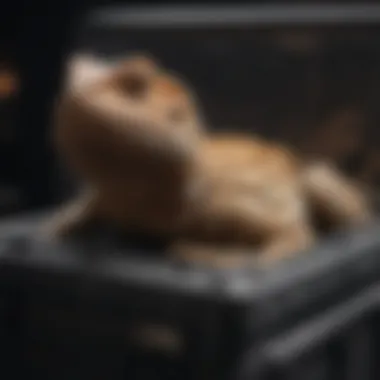Choosing the Right Bearded Dragon Travel Carrier Guide


Intro
Choosing the right travel carrier for a bearded dragon requires careful consideration. It is essential because their well-being is closely tied to safe and comfortable transport. This guide will explore what you need to know for securing your reptile during travel.
Bearded dragons, like other pets, depend on their owners for safety and health, especially in unfamiliar environments. Variou types of travel carriers, materials, sizes, and safety features will be examined to help you make the most informed choice.
Key Points to be Discussed
- Importance of selecting the right carrier for bearded dragons.
- Overview of available types of travel carriers and their unique characteristics.
- Guidelines on materials and size specifications to maintain comfort.
- Safety features to look out for in carriers.
- Additional tips for selecting carriers that suit your bearded dragon's unique needs.
In this comprehensive narrative, we will synthesize the information presented, ensuring an understanding that can enhance the travel experience for both you and your pet.
Be armed with knowledge as you set forth to choose a travel carrier that prioritizes the health and comfort of your bearded dragon.
Understanding Bearded Dragons and Their Travel Needs
Traveling with a bearded dragon requires a detailed understanding of their needs. These reptiles, though hardy, have specific requirements that must be met to ensure their safety and comfort. Choosing an appropriate travel carrier is crucial for a successful outing. The right carrier not only accommodates their size but also caters to their overall well-being during transport.
The Importance of Safe Travel
Ensuring the safety of your bearded dragon during travel is paramount. These creatures can experience significant stress, which may lead to health issues if not managed properly. Stress can also alter their behavior been they may become defensive or inactive. A reliable travel carrier provides both security and confinement, preventing escapes.
- Protection from external elements: The travel carrier should shield your dragon from factors such as extreme temperatures, drafts, and direct sunlight. This minimizes discomfort and risks related to overheating or chilling, which can be quite serious and damaging to the reptile’s system.
- Transportation Stability: Carriers should be designed for stability and firmness. An erratic drive can cause unnecessary jolting, potentially harming the bearded dragon inside, especially if the carrier is poorly structured or too spacious.
A suitable travel carrier acts as a second home for your reptile during journeys, reducing anxiety and encouraging tranquility.
Managing intense situations effectively contributes to a healthier travel experience, reassuring you as an owner that you've done your part to protect your pet.
Common Concerns When Traveling with Bearded Dragons
When planning to travel, there are several considerations to keep in mind regarding your bearded dragon. Common worries may include:
- Temperature Regulation: During the journey, bearded dragons are sensitive to heat and cold. It's vital to monitor the ambient conditions in the carrier and to ensure there is adequate ventilation.
- Feeding and Hydration Needs: These reptiles thrive on careful dietary routines. Imagine a long trip; owners may ponder on what, when, and how often their dragons will need to eat and hydrate. Planning feeding times distinguishes the possibility of hunger shock due to changes or delays in food availability.
- Social Need: Bearded dragons can feel isolated. Maintaining some friendly company, either by checking in often or creating a comfy space can help in interacting with their owners, minimizing anxiety.
Being aware of these common concerns empowers owners to take proactive measures. Such foresight aids in making informed choices about carriers, making sure nothing is left to chance during travel. The benefist of safety and well-being cannot be overstated in this context.
Types of Travel Carriers
When traveling with a bearded dragon, selecting the right carrier is crucial. Different types of travel carriers serve varied needs, ensuring that both the element of safety and comfort are appropriately catered for. Each type has distinct features that appeal to different preferences and contain necessary considerations. Here is a breakdown of the main types:
Hard-Shell Carriers


Hard-shell carriers offer significant protection for bearded dragons. Their sturdy design safeguards against potential impacts. If you expect to travel in environments where your pet faces jolts, these carriers are recommended. Generally made of plastic, glass, or durable composites, they resist bends and re-shaping, thus maintaining the structural integrity. Many models have ventilation holes and handles for ease of transport, which is beneficial.
Owners who prioritize protection from elements often prefer these carriers. Nevertheless, weight can become a drawback, especially if you will be frequently lifting the carrier. Hence, it is vital to check the weight details before decision-making. Also, when choosing this type, ensure it has temperature control features for your lizard’s comfort.
Soft-Sided Carriers
Soft-sided carriers are lighter than hard-shell options and can come with flexible designs. This makes it easier for owners to handle. The construction typically involves fabric along with structural elements for support. They provide easy access for the owner, important for checking and interacting with the bearded dragon during trips.
These carriers often include mesh panels to ensure sufficient ventilation and comfort for your pet. Their lightweight and easy transport features make soft-sided carriers highly desirable for travel. Nonetheless, you must be cautious about potential escapes, so choose a high-quality carrier with secure zippers. When gaining a soft-sided option, be sure to consider dirt repellence too, considering potential pinnacles of pet mess inside.
Backpack Style Carriers
Backpack style carriers serve a unique niche in transporting bearded dragons. They facilitate hands-free travel, essentially allowing owners to carry their pet on their back. This kind of carrier typically intensifies the aspect of convenience. Backpack carriers often have padded shoulder straps, preventing strain and discomfort for the owner over longer distances.
Moreover, these carriers include reinforcement to ensure your bearded dragon remains secure. It's essential, however, to ensure the backpack has mesh or ventilated panels for airflow. Check if the interior space can be adjusted too; tight spaces might cause stress for your pet. Backpack-style carriers can be particularly handy for outdoor adventures, as they provide unmatched mobility while keeping your pet safe.
It's essential to match your bearded dragon carrier type to your specific travel needs. Take into account the destination’s environment, expected duration of travel, and your dragon's specific requirements.
Selecting the Right Material for Your Carrier
Choosing the right material for your bearded dragon’s travel carrier is pivotal for multiple reasons. The material not only influences the safety and comfort of your reptile during transport but also affects the durability and ease of maintenance of the carrier itself. For a bearded dragon owner, understanding these factors can ensure that your pet travels in a secure and pleasant environment.
Durability and Longevity
When selecting a travel carrier, the material's durability is a primary concern. An effective carrier must withstand wear and tear, particularly if it travels frequently. Materials such as hard plastic and polyester are typically considered for their resilience. Hard plastic options like those from brands such as Petmate offer robust construction that can withstand rugged handling.
Additionally, consider how easy the carrier is to clean. Bearded dragons can occasionally shed, and proper hygiene is critical for your pet's health. Carriers made from waterproof materials repel moisture and allow for hassle-free cleaning. This feature minimizes the risk of creating a breeding ground for bacteria or odor, maintaining a sanitary environment for your pet. Therefore, the carrier should be not only durable but also practicality oriented, backed by materials that remained long-lasting.
Important: Prioritize carriers that have been tested under regular usage to assess their performance over time, ensuring they meet the demands of travel and are built to last.
Breathability and Comfort
Breathability is another crucial factor to consider when selecting materials. Bearded dragons require a well-ventilated space to regulate their body temperature, especially during travel. Look for carriers that use mesh or ventilation holes; these allow ample airflow while also keeping your pet secure. When enclosed in a carrier, increased airflow helps prevent overheating, allowing your lizard to maintain its natural behaviors.
Comfort goes hand-in-hand with materials that promote a soothing environment. Any padding within the carrier should be made from materials like cotton or fleece cause discomfort under normal travel conditions. Review carriers with removable and washable liners to maintain hygiene without compromising comfort. Providing a cozy surface also reduces the chances of distress during transit. While opting for breathable and comfort-enhancing materials, focus on those designed specifically for reptiles to cater to heater their needs.
In summary, selecting the right material for your bearded dragon's travel carrier requires careful consideration of durability, cleanliness, breathability, and comfort. These elements contribute profoundly to an essential travel experience that prioritizes your pet's health and well-being, making it imperative to scrutinize each aspect actively.
Size Specifications for Bearded Dragon Carriers
Understanding the size specifications for bearded dragon carriers is crucial for the health and well-being of your pet during travel. A carrier that is too small can lead to stress, injury, or discomfort. Conversely, a carrier that is excessively large may make it difficult for your dragon to feel secure, resulting in anxiety. Proper sizing ensures that your bearded dragon has ample space to move around, as well as places to hide. This balance is important in minimizing travel-related stress.


Determining the Appropriate Size
When considering a carrier for your bearded dragon, a few key dimensions should be noted. Firstly, measure your dragon's length from snout to tail. Carriers should ideally be longer than this measurement when the dragon is fully stretched out. A minimum length in the carrier is essential to accommodate for various postures.
Additionally, evaluate the height of the carrier. Bearded dragons often enjoy basking; thus, a taller carrier can provide space for climbing or a perch. The width is equally important; a wider base allows for a safer and more stable transport environment. Aim for a space where your reptile can comfortably turn around and sit without feeling constricted.
Generally speaking, carriers larger than your dragon's body length by at least two to three inches in every direction generally provide a good starting point for comfortable travel. Considering the smallest recommendations in terms of space will help ensure an overall positive experience.
Adjustability Features
Adjustability is another factor that speaks volumes about a carrier’s practicality and lifespan. A few manufacturers have developed designs that incorporate flexible elements. These fittings can cater to various sizes and shapes, accommodating your pet's growth or differing comfort levels. If you foresee your dragon growing, choose a carrier that offers some degree of adjustability.
Some carriers include handy transformable features like shelves or ramps, allowing your bearded dragon a more stimulating environment and mimicking aspects of their natural habitat. If possible, carriers designed with customizing options also enable owners to modify configurations based on their unique trips—all aiming for the utmost safety and comfort for the bearded dragon.
Always remember: complacency in sizing and adjustability can lead to significant discomfort for your bearded dragon. It is worth taking time to evaluate various options available.
Safety Features to Consider
Choosing a suitable carrier for your bearded dragon demands attention to specific safety features. Your dragon's safety during transport relates to both the integrity of the carrier and the comfort it provides. Even slight neglect in this area might lead to stress or harm to the pet, which is something no owner desires. By taking a deep dive into secure closures, locks, and ventilation options, one can establish a safe environment for their reptile friend during travel.
Secure Closures and Locks
Ensuring that the carrier has reliable closures is essential for security. Bearded dragons are generally calm creatures; however, sudden movements or vibrations during travel could startle them. In such circumstances, an unsecured carrier could lead to the pet escaping or getting injured.
When selecting a carrier, scrutinize the closure types. Zippers may seem common, but not all are created equal. Look for sturdy zippers that keep from being unwound easily. Furthermore, buckles can provide extra security and peace of mind.Consider a carrier that integrates multiple types of closures for enhanced safety.
Also ponder wholly on how the closure mechanism could cope with frequency of travel. Loose hardware can lead to failures and weak points on the carrier. Secure options will not only protect your beloved pet in motion but help make any trip serene too.
Ventilation Options
Next is ventilation, a crucial facet that often gets overlooked. A well-ventilated travel carrier ensures that your bearded dragon receives adequate airflow, reducing stress during the journey. Unlike mammal pets, reptiles rely on ambient temperatures far more. If the temperature rises within the carrier due to lack of proper ventilation, it could lead to overheating, which jeopardizes the health of your lizard.
Here are points to ensure proper ventilation:
- Large air holes should be arranged strategically on all sides of the carrier.
- Examine that the overall design allows airflow without risking the escape of the dragon.
- Look for carriers that feature materials which encourage good airflow without compromising safety.
Proper active chin contentment signifies your own dragon will deal interactions comfortably rather than struggle through discomfort and panic during the trip.
Preparing Your Bearded Dragon for Travel
Tips for Transporting Your Bearded Dragon


Transporting your bearded dragon requires a thoughtful approach. The wrong steps can cause significant stress for your pet. Understanding how to effectively manage their transportation enhances their safety and overall comfort.
Avoiding Stressful Conditions
Travel can be inherently stressful for bearded dragons. This stress can affect their health and well-being. Recognizing common stressors during travel is essential. Examples include loud noises, sudden movements, or being in a cramped environment. Minimize these aspects by securing your transportation area.
Opt for a transport carrier that is both spacious and adequately equipped. Your dragon should have room to move lightly without too much restriction. Use blankets or towels in the carrier to give them additional comfort during the journey. Moreover, avoid exposing them to extreme temperatures. Maintaining moderate conditions is vital.
It's also crucial to prepare them psychologically before the trip. Keep the transport time brief when possible. A gentle introduction to the carrier ahead of the journey may allow them to acclimate better. In some cases, using familiar blankets can help, creating a sense of safety during transit.
Feeding and Hydration Before Travel
Proper nourishment is central to the well-being of your bearded dragon leading up to their travel time. Always consider their diet and hydration needs. Regardless of how long the journey is, feeding them in advance aids in reducing the stress often caused by an empty belly.
Offer a light meal a few hours prior to the trip. This easy meal can lower anxiety and can help prevent nausea. Make sure that your dragon is adequately hydrated. Ensure they have access to fresh water. Keeping them hydrated will reduce fatigue and promote overall health during the trip.
Client input is noted that the points offered will contribute to a positive travel experience for your pet. Remember, taking extra steps today ensures a healthier tomorrow for your scaly friends.>
Access useful information about reptile care on platforms such as Wikipedia, Britannica, or community-based discussions on Reddit and Facebook.
Post-Travel Considerations
Post-travel considerations are essential for ensuring that your bearded dragon transitions smoothly back to its regular environment. After a journey, reptiles can experience stress that may affect their health. Addressing these post-travel matters ensures your pet’s well-being.
When returning from a trip, you might notice changes in your bearded dragon’s behavior. These changes can range from unusual lethargy to excessive hissing. Recognizing these signs early supports effective management. Owners must pay careful attention to their dragon’s demeanor during this period. Here's why it's crucial:
- The adjustment from a carrier to its home environment can create discomfort.
- Stress may result in health complications if not managed properly.
- Actions taken in response to stress can impact your dragon's long-term comfort.
Checking for Signs of Stress
Signs of stress in a bearded dragon can manifest in various ways. Some common indicators include appearing disinterested in food or frequent hiding. Recognizing these symptoms early plays a key role in enabling quick action.
Factors to consider include the following:
- Behavioral Changes: Reduced appetite or aggression toward handling may point to stress.
- Physical Signs: Look for signs such as shedding issues, weight loss, or unusual droppings. These signs indicate that your dragon may need proper care.
- Mood Variability: Sudden bursts of energy followed by lethargy often suggests an adjustment struggle after travel.
It's important to monitor these changes and communicate with a veterinarian if they persist. Early intervention ensures the health and stability of your pet.
Re-establishing Comfort Zones
After travel, re-establishing comfort zones is vital for your bearded dragon. Returning to familiar surroundings and routines aids in recovery from stress. Animals thrive on familiarity, which means that recreating a comforting environment can significantly aid in their adjustment.
Key steps involve:
- Returning to a Familiar Habitat: Ensure that your dragon's enclosure maintains previous settings and temperature standards to support its needs.
- Gradual Interaction: Allow your dragon some alone time before resuming typical handling practices. This measure can help your pet acclimate.
- Consistent Feeding Routine: Returning to normal meal times and preferences helps reinforce a sense of stability.
Effective integration of these practices fosters a recuperative environment for your bearded dragon after its travel ordeal. Continuously observing your pet ensures its comfort and builds trust between you both.
Taking these post-travel considerations seriously can help maintain your bearded dragon's health and happiness, significantly benefiting bonding over time.















